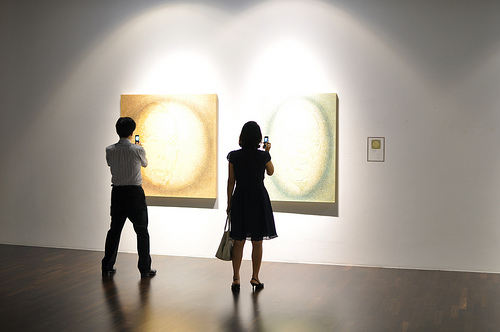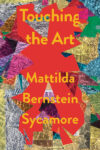
Photo via NinaSpace
Have you been to an art museum lately? I used to go to the Metropolitan Museum of Art and the Museum of Modern Art all the time in the first year after I moved to New York. I love that we have large institutions devoted to high culture at prices accessible to the poor, namely myself. And I like that they’ve treated themselves and been treated as rare and sacred spaces for contemplative quietude. I can’t deal with the weekend crowds, so I hadn’t been to either museum in almost two years when I went to the Met last week.
I started in 19th century European art, and I was really into a Cezanne, The Fishermen, when a woman about my age walked in front of me, quickly snapped a photo with her phone and, without putting the phone down to see the painting with her eyes, moved onto the next painting. Throughout the next two hours, the same thing happened at nearly every single piece of art I stood in front of. Almost every photograph was being photographed at every moment, some with phones and some with digital SLRs with the flash on.
It made the museum unpleasant, not just because the photographers were distracting, which they were (you detract from my transcendental sense of wonder at the Monet when you take a selfie in front of it, you crass fucking goobers). But I sensed that what I was feeling went beyond annoyance and was more like an acute sense of alienation. At what though?
You can see a professional photograph of any painting in the museum on the Met’s website, or on Instagram or Flickr or whatever. Did everyone in the museum think their shitty iPhone pics would be more personal, or maybe they were after authenticity? Some of its cheaply expressive, like peace signs over The Starry Night. I don’t understand the appeal. I think it’s dumb and horrible and now I feel a little more distant from humanity, which is the opposite of how I wanted to feel while looking at a full size Egyptian temple on the Met’s ground floor.
I discovered the Met had amended its visitor policy in 2012 to allow photography in its permanent collections in suit with a growing number of museums that have done the same in the last few years, including the Museum of Modern Art, the National Gallery of Art, the Brooklyn Museum, the Getty Museum and the Art Institute of Chicago, to name a few.
My research lead me to a handful of blogs run by museum administrators, all of which cheer-lead the photography policy reforms. An older post by Nina Simon, executive director of the Santa Cruz Museum of Art and History, which has an open photography policy, best summarized the argument. Simon noted what she saw as the primary complaints against museum photography: that it potentially violates intellectual property; that flash photography can damage the condition of the artworks; that it interferes with the museums’ revenue streams (visitors won’t buy reproductions in the gift shop); that it detracts from some visitors’ aesthetic experience; and that photographs could be used to case a museum in preparation for an art heist. Simon wrote that she sympathized with the first two points and that they need to be considered in the creation of museum policy or certain shows, but she found the last two points “bizarre and ungenerous to visitors.”
I’m not concerned with the economics of gift shops or intellectual property. The majority of these artists are long dead, and I agree that art thieves are generally clever enough to navigate around museum policy, but why is the issue of distraction “bizarre and ungenerous”?
“To me, an open photo policy is a cornerstone of any institution that sees itself as a visitor-centered platform for participatory engagement,” Simon writes, mirroring the fundamental reasoning behind all shifting museum photography policies. She goes on to argue the following points, in summary:
“1. As long as it does not promote unsafe conditions for artifacts or people or illegal behavior, museums should prioritize providing opportunities for visitors to engage in ways that are familiar and comfortable to them.
2. Restrictive policies erode staff/visitor relations and overall museum mission statements around inclusion.
3. Photo-taking allows visitors to memorialize and make meaning from museum experiences.
4. Visitors use personal photos differently from store-bought ones. The majority of visitors use their cameras to casually record their personal and social experiences, not to take authoritative images of artifacts. A visitor who wants a picture of “mom with the giant penis statue” wants something that the museum is not selling.
5. (I feel this one warrants Simon’s full explanation) When people share their photos of your museum, they promote and spread your content to new audiences in authentic ways. In 2008, a team led by MIT media researcher Henry Jenkins published a white paper entitled, “If it Doesn’t Spread, It’s Dead,” which argues that media artifacts have greatest impact when consumers are able to pass on, reuse, adapt, and remix them. There are two parts to this. First, every time a photo is shared, it extends the reach of your objects and exhibit stories. But perhaps more importantly, Jenkins argues that the creative adaptation of cultural objects through photos and other spreading tools supports communities’ “processes of meaning making, as people use tools at their disposal to explain the world around them.”
In an ArtNews story from last year, several museum administrators explained the changing photo policies were partially motivated by resignation and restriction of resources. There’s so many cameras now that it’s more important for the museums’ security guards to watch for people touching the art than to spend all their time telling people not to take pictures.
This all makes sense to me, but I still reject it. At a surface level, I don’t think my desire to engage with a work of art using only my body and consciousness is in threat of extinction, it seems so native to us, though perhaps it’s given up on the Met. I don’t think I’m to being an elitist, at least not an elitist in the general sense, when I feel strongly that other peoples’ photography cheapens the museum-going experience.
Institutional relevancy? Engagement? Museums are willing to concede the vulgar desecration of our most sacred objects to suit the fickle whims of the lowest cultural common denominator, the tourist. Their whole job is to protect the objects and preserve a safe space for concentration as attention spans fall and sea levels rise. If I’m an elitist, I don’t think I’m on the wrong side of the class war. It was a Monday and the museum was mostly populated by wealthy looking people.
Were Walter Benjamin alive today would he accuse me of buying into the pseudo-spiritual aura surrounding the art at the Met, the veil disguising the inequities that support institutional philanthropy and the capital of certain names? I think he’d like smartphones but he’d be horrified by how they were being used in museums. I guess I’m attracted to the “sure don’t make em’ like that anymore” factor of the museum’s collection, just like everybody else. Isn’t that the reason these shutterbugs are running amok about the institution, so they can bring that historical home with them to disseminate on the projector before a drooling horde of family and friends?
A fear of the barbarians at the gates. I think this is what bothered me most. It’s horrifying to find yourself horrified when confronted with what’s supposedly a democratizing feature, and you recognize the truth of the barbarism inherent in man, half-agreeing with Hobbes. Technology, whether a smartphone camera or an activist Twitter handle, isn’t democratizing or its opposite, though. It’s a tool like a screwdriver that can either build or stab. Democracy can eat itself or not. Readers of this website don’t need the litany. But I’m still disgusted, and not with myself. I’m overwhelmed by all the cameras in general, and I think in addition to annoyance at their pervasive distraction, what I’m responding to is something like a widespread uncritical complaisance in the surveillance state.
It’s easy to see and critique the parts of increasingly omnipresent surveillance that are subjected upon us, like CCTV, drones, facial recognition software in public space, etc. It’s much more troubling to accept the darkest lesson of all the dystopian poets: that we are all active participants in the creation and perpetuation of creeping fascism. The system is us, and it often takes an odd event, whether personal like my day at the museum, or public like “the fappening,” to internalize what that means. We as a society have been offered new tools in the construction of power and given little serious ethical consideration to how we should use them. Pixar’s Wall-E is the best example I can think of. In failing to honor a responsibility to the ethical dimension, we’ve squandered both the moral weight of being and the public spaces we’ve long set aside for personal encounters with the sublime.
This isn’t human nature — nothing is. This is a reaction to a void where there should be very public discussion of the choices we’re making with technology. Baby with the bathwater? and related questions. Surely that conversation is taking place between a limited number of people online, but it ought to be subjected upon the iPhone wielding masses through mass media. We live in a world of gatekeepers, kept in place by the same economic system that produces the iPhone and the salaries of museum administrators. As long it and they exist and until they’re replaced with a more functional and egalitarian system for society to have a serious and organized conversation with itself, the anchors of CNN and the people in the top offices of the Met should be held accountable for addressing, questioning, interpreting and protecting the meaning of privacy in an increasingly digital and public (or at least a kind of public) social landscape. A roundtable discussion on CNN concerning personal photography and creeping fascism isn’t going to happen, but at the least the Met could have held some kind of well advertised public discussion before dumbing itself down. Probably that wouldn’t have changed anything. Most people like, or at least feel compelled to, take pictures at art museums. It would have at least appeared like the possibility of agency or even public engagement.
For an alternative view on the same phone-omenon, check out Sam Kriss’s “Why Mobile Phone Are Good for Art.”
This post may contain affiliate links.







